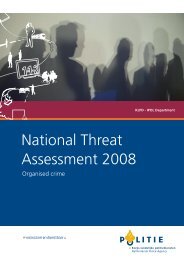Assessing the Effectiveness of Organized Crime Control Strategies ...
Assessing the Effectiveness of Organized Crime Control Strategies ...
Assessing the Effectiveness of Organized Crime Control Strategies ...
Create successful ePaper yourself
Turn your PDF publications into a flip-book with our unique Google optimized e-Paper software.
year in <strong>the</strong> US (Shannon, 1988:410). In 1992, US Customs inspected just 13 percent <strong>of</strong> full<br />
shipping containers from cocaine source and transit countries (US General Accounting Office,<br />
1994:5). Even if agents could inspect each container arriving by sea from South America, <strong>the</strong><br />
traffickers could still move cocaine and o<strong>the</strong>r contraband via inland routes through Mexico.<br />
Inspecting each truck at <strong>the</strong> Mexican border would paralyze commerce, causing delays that<br />
would cause fruits and vegetables to rot. Two-thirds <strong>of</strong> all cocaine entering <strong>the</strong> US is brought<br />
across <strong>the</strong> US-Mexico land border concealed in cargo (US General Accounting Office, 1994:5).<br />
As for interdiction <strong>of</strong> <strong>the</strong> airborne drug traffic, just 5 percent <strong>of</strong> planes crossing into <strong>the</strong><br />
southwestern US are intercepted (Shannon, 1988:419).<br />
The United States’ General Accounting Office (1994:1) has put it bluntly: “Despite various US<br />
government interdiction efforts, Central America continues to be a primary transshipment point<br />
for cocaine shipments to <strong>the</strong> United States. Available evidence suggests that <strong>the</strong> supply <strong>of</strong> drugs<br />
entering <strong>the</strong> United States via Central America remains virtually uninterrupted.” The GAO<br />
report says that Central American countries tend to lack <strong>the</strong> resources and institutional capacity<br />
to address <strong>the</strong> new drug trafficking modes. Also, drug traffickers are adept at adjusting <strong>the</strong>ir<br />
routes, modes <strong>of</strong> transportation and concealment, and times <strong>of</strong> entry in response to interdiction<br />
efforts (Reuter, Crawford, and Cave, 1988).<br />
The problems <strong>of</strong> interdiction notwithstanding, an econometric analysis commissioned by <strong>the</strong> US<br />
Customs Service (Godshaw, Koppel, and Pancoast, 1987) revealed that interdiction strategies are<br />
more cost effective than domestic anti-drug investigations, as <strong>the</strong>y yield greater amounts <strong>of</strong><br />
contraband seized. In 1986, a dollar spent on interdiction yielded over seven dollars (retail<br />
value) in cocaine and marijuana seizures, whereas a dollar spent on investigation yielded just<br />
over three dollars in seizures. Interdiction at <strong>the</strong> border has <strong>the</strong> additional advantage <strong>of</strong> lessening<br />
<strong>the</strong> social costs <strong>of</strong> drugs, as intercepted substances never generate <strong>the</strong> social and health-related<br />
problems associated with drug distribution and use. This study also found that a ten percent<br />
increase in law enforcement expenditures increases <strong>the</strong> cost <strong>of</strong> illicit drugs and <strong>the</strong>reby occasions<br />
a 4 percent drop in marijuana consumption and a 2.4 percent drop in cocaine consumption.<br />
While cost may be a factor in consumption levels, o<strong>the</strong>r studies indicate that consumption is<br />
unrelated to availability, <strong>the</strong>reby undermining <strong>the</strong> supply-reduction approach (Jonas, 1999:127).<br />
Moore (1990:148) argues that frustrating illicit transactions through law enforcement efforts and<br />
immobilizing trafficking networks may be more useful supply-reduction strategies than<br />
interdiction. He asserts, however, that <strong>the</strong> existing approach is based on “bets and gambles”<br />
ra<strong>the</strong>r than hard evidence. Moore (1990:152) adds that “it is vital that capacities be improved for<br />
measuring not only <strong>the</strong> impact <strong>of</strong> <strong>the</strong> supply-reduction strategy but also its operations. Without<br />
such measurements that provide evidence about what works and what does not, <strong>the</strong>re is no<br />
prospect for improving ei<strong>the</strong>r our knowledge or our performance.”<br />
4.17 Increasing Regulation and Establishing Public Benefit Corporations<br />
Increasing regulation and enforcement in various industries may make <strong>the</strong>m less vulnerable to<br />
infiltration by OC groups. For example, OC has been described as entrenched in <strong>the</strong> waste<br />
hauling industries in <strong>the</strong> states <strong>of</strong> New York and New Jersey (Carter, 1996/97: 32). The<br />
introduction <strong>of</strong> environmental regulations dramatically increased <strong>the</strong> cost <strong>of</strong> waste disposal,<br />
Research and Statistics Division / Department <strong>of</strong> Justice Canada | 51








